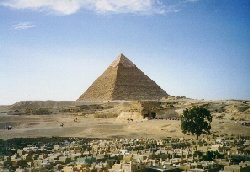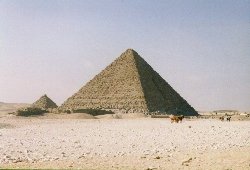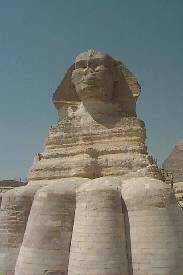|
The
Giza Plateau:
Necropolis
from a Golden Age
Situated
west of the Nile, bordering the Sahara Desert, the Giza plateau rises up in
its glory to present its full authority. It is here that an ancient King coordinated
a mammoth undertaking exploiting the full value of the looming plateau. Eternal
life would surely be granted with the precision and meticulous execution of
King Khufu's perfect pyramid. Other pyramids had been built before, but none
would ever achieve the genius, grace and competence of this Great Pyramid.
Still standing today, it stands a silent witness to the events that immediately
followed the kings decision to build his pyramid on this site. Strangely,
Khufu decided to build his pyramid just to one side of the highest ground
on the plateau. Perhaps this section would require less work to lay the foundation,
over 9 acres, of the pyramid. We can begin to surmise how the pyramid was
built by the abundant evidence at the site. A project of this magnitude would
require people, housing, food and tools. Traces of all of this have been found,
and a small village has been excavated that would be sufficient to house the
appropriate number of people necessary to build the largest pyramid. The graffiti
of the original work gangs are scrawled across the upper most chambers, chambers
that were never meant to be entered, which may have only been included to
relieve the tremendous weight upon the main chamber.
Following
the lead of Khufu, two of his successors also built their pyramids on the
plateau. His son, Khafre, exploited the higher ground, and was able to achieve
the illusion of his pyramid as being the tallest. In actuality, his pyramid
was shorter than Khufu's. Khafre is assumed to have been responsible for carving
the Great Sphinx which is aligned to his pyramid. The smallest pyramid, that
of Menkaura, was the final attempt to pyramid the plateau. Menkaura's pyramid
also suffered the fate of other pyramids and tombs throughout Egyptian history,
the king died before his tomb was finished.
 The Great Pyramid - The first stop on our tour
of the Giza plateau is the Great Pyramid of the 4th Dynasty King, Khufu.
It was the first pyramid constructed on the plateau and many consider that
it represents the pinnacle of the pyramid age. This pyramid contains ascending
chambers and passageways not found in any other pyramids. This is how it
appears from the south face. On the bottom right hand side is a special
museum which contains a 5000 year old boat which we will also explore in
another section. We will also enter this pyramid and explore its unique
internal arrangement.
The Great Pyramid - The first stop on our tour
of the Giza plateau is the Great Pyramid of the 4th Dynasty King, Khufu.
It was the first pyramid constructed on the plateau and many consider that
it represents the pinnacle of the pyramid age. This pyramid contains ascending
chambers and passageways not found in any other pyramids. This is how it
appears from the south face. On the bottom right hand side is a special
museum which contains a 5000 year old boat which we will also explore in
another section. We will also enter this pyramid and explore its unique
internal arrangement.
 The Pyramid of Khafre - Our next stop is the
Pyramid of Khafre. Khafre was a son of Khufu and his is the second largest
known pyramid in Egypt, only approximately 10 meters shorter that the Great
Pyramid. This is how the pyramid appears from its eastern face with several
tombs in the foreground. Remnants of its original casing are still apparent
at the top of the structure. Although this pyramid boasts two entrances,
only one is open and it is through this opening that we will explore the
interior of this marvelous edifice to Khafre.
The Pyramid of Khafre - Our next stop is the
Pyramid of Khafre. Khafre was a son of Khufu and his is the second largest
known pyramid in Egypt, only approximately 10 meters shorter that the Great
Pyramid. This is how the pyramid appears from its eastern face with several
tombs in the foreground. Remnants of its original casing are still apparent
at the top of the structure. Although this pyramid boasts two entrances,
only one is open and it is through this opening that we will explore the
interior of this marvelous edifice to Khafre.
 The Pyramid of Menkaura - Next stop, the Pyramid
of Menkaura, son of Khafre. Although much smaller than the other two pyramids
on the plateau, the lower courses were originally encased in granite. It
has three subsidiary pyramids and some of its Mortuary temple remains intact.
We will enter this pyramid and see its unique layout, which included a room
possibly for the burial of some of the king's family as well as the
king himself.
The Pyramid of Menkaura - Next stop, the Pyramid
of Menkaura, son of Khafre. Although much smaller than the other two pyramids
on the plateau, the lower courses were originally encased in granite. It
has three subsidiary pyramids and some of its Mortuary temple remains intact.
We will enter this pyramid and see its unique layout, which included a room
possibly for the burial of some of the king's family as well as the
king himself.
 The Great Sphinx - The famous Sphinx of Egypt
is a site to behold. The head of a king, body of a lion, this colossus is
carved out of the very bedrock in which it sits. Recently restored, you
can see it up close and personal and explore its mysterious presence. You'll
see all sides of the Sphinx and even between the paws.
The Great Sphinx - The famous Sphinx of Egypt
is a site to behold. The head of a king, body of a lion, this colossus is
carved out of the very bedrock in which it sits. Recently restored, you
can see it up close and personal and explore its mysterious presence. You'll
see all sides of the Sphinx and even between the paws.
Special thanks to:
Guardian's Egypt - Copyright © 1995-99 Andrew Bayuk All Rights Reserved
|





